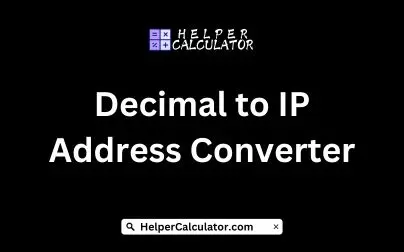A Decimal to IP Address Converter is a tool or program designed to convert a given decimal value (typically a 32-bit unsigned integer) into its equivalent IPv4 address in the dotted decimal format (e.g., "192.168.0.1").
IPv4 addresses are written as four decimal numbers separated by dots, where each number represents 8 bits of the 32-bit address. The process of converting a decimal number into an IP address involves breaking down the decimal value into four octets (8-bit segments), and then converting each octet into its corresponding decimal value.
Overview of the Process
1. 32-bit Decimal Number:
- An IPv4 address is a 32-bit integer, meaning it has a value that ranges from 0 to 4,294,967,295 (i.e., 2^32 - 1). This number is often represented in dotted decimal notation.
2. Binary Representation:
- Each 32-bit decimal number can be converted into a binary representation, which is a string of 32 bits (ones and zeros).
3. Breaking into 4 Octets:
- The 32-bit binary number is divided into four groups of 8 bits (or one byte), each representing one of the octets of the IP address.
4. Converting to Decimal:
- Each 8-bit segment (octet) is then converted back into its decimal representation.
5. Forming the Final IP Address:
- The four decimal numbers (from each octet) are joined together with periods to form the final IPv4 address.
Example Conversion
Let's walk through an example to demonstrate the conversion.
Example: Convert the decimal number "3232235776" to an IPv4 address.
1. Decimal to Binary:
- 3232235776 in decimal is "11000000101010000000000100000000" in binary (32 bits).
2. Break into 4 Octets:
- Divide the binary string into 4 groups of 8 bits:
- "11000000" (First octet)
- "10101000" (Second octet)
- "00000001" (Third octet)
- "00000000" (Fourth octet)
3. Convert Each Octet to Decimal:
- "11000000" in binary is "192" in decimal.
- "10101000" in binary is "168" in decimal.
- "00000001" in binary is "1" in decimal.
- "00000000" in binary is "0" in decimal.
4. Final IP Address:
- Combining the four decimal numbers gives us the IPv4 address: "192.168.0.0".
Key Concepts and Definitions
- IPv4 Address: An IPv4 address is a 32-bit address that identifies a device on a network, often written as four decimal numbers (octets), each ranging from 0 to 255 (e.g., "192.168.1.1").
- Decimal to Binary Conversion: Converting a decimal number to binary involves dividing the number by 2 and recording the remainders.
- IP Address Format: In the dotted-decimal format, an IP address consists of four decimal numbers (each between 0 and 255) separated by periods (dots).
- Subnetting: The 32-bit address can also be divided into a network part and a host part using a subnet mask. While converting decimal to IP is a simple transformation, subnetting plays a key role in addressing within a network.
Use Cases for a Decimal to IP Converter
- Network Configuration: Systems often need to display IP addresses as dotted decimal numbers for easier human understanding. Converting from decimal format (used in network protocols) to a readable format is useful for configuration and management.
- Subnet Calculations: When calculating subnets, administrators may need to convert decimal numbers (like network address ranges) into their IP address equivalents.
- IP Address Analysis: If you're working with logs or raw network data, you may encounter IP addresses stored in decimal format. A converter can help translate them into readable format.
A Decimal to IP Address Converter is a straightforward but powerful tool in network management, used to transform an integer representation of an IP address into a more human-readable form. It’s valuable for configuring networks, understanding log files, and performing subnetting and other network-related tasks. By understanding the conversion process, you can easily move between different representations of network addresses.
Decimal to IP Converter
Tags:
Unit Conversion Tools
